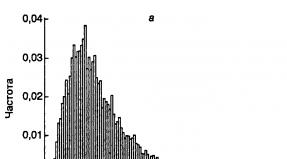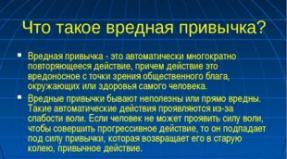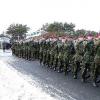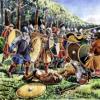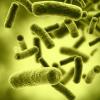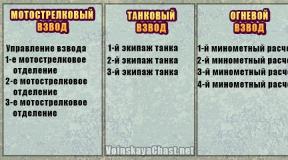Minisatellite DNA-based identification: determining paternity. Dna identification to determine relationship The meaning of dna identification in English
Determination of paternity is a serious social, legal and medical problem. The solution to this problem is often required in courts, when resolving private disputes, for prenatal (intrauterine) diagnostics, genetic counseling and organ transplants. For example, in the United States alone in 1990, more than 120,000 paternity tests were performed, and this number is rapidly increasing. The world market for such diagnostic test kits was estimated in 1994 at more than $ 1 billion and is now the largest market for molecular genetic diagnostics.
With the use of diagnostic test systems based on minisatellite DNA, the determination of paternity has received a solid scientific basis. To this end, two approaches are currently used. One of them uses oligonucleotide probes specific for many minisatellite loci, while the other uses sets of probes (or primers) specific for individual polymorphic VNTR loci (for more details on VNTR, see Section 1.3.1).
Theoretical aspects of the possibility of determining paternity. The ability to determine paternity, as well as the attribution of biological samples containing DNA to a particular person, is based on the presence in the human genome of clear genetic markers in the form of certain DNA sequences, the set of which is unique for a particular individual. Theoretically, such markers could be any DNA nucleotide sequences that are characterized by great variability in human populations. As noted above, tandem repetitive sequences of minisatellites (VNTR) are one of the most polymorphic nucleotide sequences in the human genome. Therefore, it is not surprising that they were used for personal identification. The presence of a combination of genetic markers among VNTRs that are common for a man, a woman, and a disputable child, in some cases, may unambiguously indicate the relationship between them.
The absence of common genetic markers in the examined child and man unambiguously excludes the latter as the child's father. However, the discovery of common markers in them still cannot be proof that the suspected man is the father. Evidence of paternity is based on simple statistical calculations that take into account the frequencies of common alleles in the population of the studied VNTR loci. The ratio (X / Y) of the probability (X) of obtaining the observed set of markers of a possible real father to the probability (Y) of detecting this set of markers in any random person belonging to this population is calculated. This ratio of probabilities is called paternity index (paternity index - PI).
When calculating PI, another problem arises in determining the probability (X) that the surveyed man is the father. This probability should be considered before any diagnostic tests are performed. The commonly used value of 0.5 cannot be considered sufficiently reasonable in all specific cases. Fortunately, at very high PI values \u200b\u200b(\u003e 10 4), which are usually obtained in such DNA studies, the choice of this initial probability turns out to be practically insignificant. As a rule, this is due to the low values \u200b\u200bof the probability Y.
Determination of paternity using oligonucleotide probes specific for several VNTR loci. In 1985 I.O. Jeffries et al. Were the first to show that oligonucleotide probes complementary to the human myoglobin gene sequences simultaneously have the ability to hybridize according to Southern with multiple minisatellite DNA loci. The hybridization profiles were found to be specific for individual individuals. The set of electrophoretically separating restriction fragments of the analyzed DNA detected after hybridization with labeled probes, which are specific for polymorphic minisatellite loci, is called DNA fingerprints, or genetic fingerprints... With the help of such and other similar oligonucleotide probes, it is possible to identify on one electrophoregram up to 15-20 different DNA fragments of one individual, the molecular weight of which exceeds 3.5 kbp, as well as many smaller fragments that are not taken into account when determining paternity by this method.
Fig. II.36. Examples of exclusion and proof of paternity using DNA typing
The results of Southern hybridization with the F10 probe show complete identity of the DNA fragments in the child and the father (lanes 2 and 3), which is considered as proof of paternity, or reveal at least 6 additional DNA fragments in the child, indicated by arrows, which are absent in the father (tracks 5 and 6 - exclusion of paternity)
In fig. II.36 shows the results of one such experiment. Interpretation of DNA fingerprints obtained from analysis of multiple loci is based on three postulates. First of all, it is assumed that DNA fragments visible on fingerprints are allelic products of individual human genetic loci and are transmitted to offspring independently of each other. Second, it is believed that, for each genetic locus, the frequencies of individual alleles in the population follow the normal Poisson distribution. Finally, it is assumed that DNA fragments whose electrophoretic mobility is the same represent the same allele of a particular locus. The accumulated experience of working with DNA fingerprints shows that the first assumption is met quite well: allelism (a pair of homologous genes that determine different phenotypic traits in diploid organisms) and genetic linkage between the studied loci are rarely observed. Failure to fulfill the second assumption does not seriously affect the test results, since conclusions are drawn without taking into account the frequency of occurrence of a single allele based on the coincidence of the structure (DNA fragments) of many loci. The third postulate is more controversial, but its application gives stability to the values \u200b\u200bof the paternity index.
With these initial conditions, the statistical evaluation of DNA fingerprints of multiple loci is based on only one parameter: the average fraction of DNA fragments ( x), which are the same in people without family ties. This parameter depends more on the laboratory research technique than on the properties of the studied population. These are, first of all, the ability of the system used for electrophoretic separation of individual DNA fragments (i.e., the resolution of the method used), the principles of selecting specific DNA fragments for analysis, as well as the criteria for deciding on the identity of the compared DNA fragments. Consequently, the parameter x may vary when comparing results obtained in different laboratories, but these differences will persist for different populations and subpopulations. Indeed, when using, for example, probes 33.6 and 33.15, it turned out that x the same in unrelated individuals, in husband-wife pairs and in different ethnic groups.

Fig. II.37. Comparison of the information content of two minisatellite probes in personal identification
The frequencies of occurrence of minisatellite loci D1S7 ( and) and D1S80 ( b) of a certain size in the population was assessed by Southern hybridization after DNA digestion with a restriction enzyme HaeIII ( and) or PCR ( b). The D1S7 locus is characterized by a quasi-continuous unimodal distribution, while the D1S80 locus is characterized by less heterozygosity (84%) with a small number of discrete alleles, which are characterized by a multimodal distribution
Determination of paternity using DNA probes specific for only one locus. DNA fingerprints obtained from the simultaneous examination of many loci reflect the phenotype of the individual rather than his genotype. Indeed, the resulting picture contains many DNA bands, including unseparated, as well as weakly separated fractions. Such an electrophoregram resembles a complex phenotypic trait, for example, the shape of a person's face, which is the result of the expression of a huge number of genes. In contrast, with the help of DNA probes, which are cloned sequences of minisatellites and interact with only one locus, it is possible to obtain true information about the genotype of the organism under study. Thus, when dealing with individual polymorphic human loci, researchers get their hands on a system codominant alleles (i.e. alleles, jointly participating in the formation of phenotypic traits), inherited according to Mendel's laws. It was the understanding of the inheritance of such minisatellite loci that led to the widespread use of the single-locus method for determining paternity.
At present, hundreds of minisatellite DNA clones have been obtained and, on their basis, combinations of probes have been developed that are suitable for determining paternity. When choosing probes for such minisatellite loci, the following criteria are usually guided: probes must have strict locus-specificity, and the tested loci must be unlinked (transmitted to offspring independently of each other) and have sufficient, but not excessive, genetic stability. In particular, among the most widely used probes, MS1 (D1S7) corresponds to a genetic locus that is heterozygous in 99% of cases, but it mutates at a very high frequency (0.05 per gamete) and therefore, despite its high information content, it is not used in determining paternity ( fig. II.37, and). At the same time, the D1S80 locus with a much lower variability (84% of heterozygotes) is characterized by the formation of clusters in the frequencies of the length distribution of the DNA fragment (see Fig. II.37, b). Therefore, small errors in determining the length of alleles can lead to significant errors in assessing the frequency of their occurrence. Such loci are quite easily changed as a result of genetic drift and inbreeding.
At present, a theory has been developed that indicates how many loci should be typed in order to obtain the correct answer about paternity at known values \u200b\u200bof the heterozygosity of these loci in the population. For example, if loci with 90% heterozygosity are used, six such loci must be analyzed to establish paternity. In the United States, a set of three to five single-locus probes is currently used for this purpose. Single-focus probes have low resolution relative to brothers and sisters ( siblings). In particular, with the help of one such probe, it is possible to detect genetic differences between siblings with only a 75% probability, and this probability increases to 99.6% when using four probes. This fact becomes especially important when, in determining paternity, it is necessary to make a choice between brothers.
Specifics of determining paternity at individual loci using PCR. As an alternative to single-locus probes, PCR has recently been used to determine paternity. Individual mini- and microsatellite loci can be amplified using primers complementary to the unique DNA sequences flanking these repetitive sequences. When identifying a person, the PCR method, which in its essence is one of the varieties of the single-locus technique, since it deals with individual loci, has at least two advantages over single-locus probes. First, the population polymorphism of the DNA lengths of the alleles studied using this method is more discrete than that of the alleles studied using single-locus probes (see Fig. II.37, and,b). This circumstance facilitates the subsequent calculation of the paternity index. Secondly, the PCR method is much more sensitive and can be used in the analysis of samples containing<1 нг геномной ДНК и полученных из разных источников (см. раздел 11.1.1).
The disadvantages of PCR as applied to the determination of paternity include the low information content of polymorphic microsatellites and short minisatellites. This is due to the fact that they possess<90% гетерозиготности, небольшим числом аллелей и имеют тенденцию к образованию кластеров по размерам (см. рис. II.37,b). In addition, the distribution of such sequences in the genome is influenced by inbreeding and the belonging of individuals to certain ethnic groups. The number of loci of minisatellites, which must be investigated by PCR to determine paternity, is close to 11, and of microsatellites - to 18.
Three human minisatellite loci are most commonly used for PCR typing: in the apolipoprotein B (APOB) gene, D17S5 (also known as the D17S30 locus), and D1S80. All three loci are easily amplified (the maximum size of their allelic variants does not exceed 1 kb) and are easily detected by electrophoresis. However, they are characterized by a low level of heterozygosity and low variability (which is expressed in a small number of known alleles). Mutations in these microsatellites are very rare.
One of the ways to increase the information content of microsatellite polymorphisms during DNA typing is the simultaneous amplification of two closely linked microsatellite loci, the combinations of which form many haplotypes... For example, simultaneous amplification of two GATA repeats localized in intron 40 of the von Willebrand factor gene, which are separated by a 212 bp sequence, revealed a total level of heterozygosity of the combined locus of 93%. At the same time, the levels of heterozygosity of individual loci were only 72 and 78%, respectively.
In conclusion, it should be noted once again that, according to their logic, modern methods of determining paternity, based on DNA typing, are somewhat contradictory. If a negative conclusion about paternity, based on the mismatch of alleles of the analyzed mini- or microsatellite loci, is absolutely beyond doubt, then a positive conclusion can only be made with a certain degree of probability, which is based on the frequency of occurrence of specific alleles of the analyzed loci in the population. On the other hand, as a result of methodological errors, false negative conclusions can easily be drawn, but a positive conclusion about paternity as a result of a laboratory methodological error is practically excluded.
The high information content of multilocus DNA fingerprints has been confirmed by a large number of genetic and population studies. Empirical evidence from thousands of families has shown that all disputed paternity cases can be resolved with multi-locus probes. The use of single-locus probes is hampered by the impossibility of creating a complete classification of the corresponding alleles in the population due to their seemingly continuous size distribution. However, even in this case, in practice, the problem is completely solved using a set of five or six single-locus probes. The use of PCR is limited by the large evolutionary conservatism of the amplified mini- and microsatellite loci and, as a consequence, by the small total number of alleles. However, PCR can be very useful at the first stages of research due to the methodological simplicity of setting up experiments, especially in conditions of low availability of the initial biological material. All three groups of methods complement each other well and, in various combinations, in controversial cases, make it possible to unambiguously identify a person's personality.
DNA IDENTIFICATION
or DNA typing, establishing the genetic identity of any organism based on the analysis of the characteristics of its deoxyribonucleic acid (DNA). The DNA "profile" obtained during typing, like fingerprints, can be used for personal identification.
Typing is based on two characteristics of DNA as a carrier of genetic information: 1) the sequence of elements (nucleotides) constituting DNA has individual characteristics in each individual animal or plant, except for identical (identical) twins or cloned organisms; 2) in each individual, the DNA of all somatic cells (body cells) is exactly the same.
Any biological material from a living or dead organism can be used for DNA identification, for example, blood, seminal fluid, saliva, hair roots, skin, or leaves or plant seeds. It is only important that the DNA is not destroyed. In practice, when carrying out genetic typing in order to identify a person or the degree of genetic relationship (proximity or remoteness), DNA profiles from several biological samples are compared and the result is evaluated using probabilistic and statistical analysis.
The typing procedure consists of the following main stages: isolation (extraction) of DNA from biological material; "cutting" the resulting DNA into fragments of different lengths using special enzymes; dividing and arranging fragments by size; hybridization (binding) of the obtained DNA fragments with radioactive probes - chains of similar DNA; fixation of the spatial distribution of fragments by radio autography, i.e. on x-ray film. Fragments of the analyzed DNA associated with radioactive probes illuminate X-ray film in the form of black stripes located under each other, so that the DNA radio autograph looks like bar codes on the packaging of goods in stores.
DNA typing finds a variety of applications: in population genetic research to determine the origin of populations of people, animals or plants; in the practice of forensic medicine for the analysis of biological evidence; to determine paternity or degree of relationship; for genetic analysis of bone marrow cells during its transplantation from a donor to a recipient; to determine the origin of hunting trophies or meat in cases of poaching; in breeding work to reduce the likelihood of inbreeding (closely related crossing) when breeding endangered species; for the selection of genetic markers in animals and plants that allow tracing the fate of parental traits in generations; to resolve controversial issues of authorship when patenting strains of microorganisms and plants; to analyze the evolutionary origin of biological species. See also NUCLEIC ACIDS.
Collier. Collier's Dictionary. 2012
See also the interpretation, synonyms, meanings of the word and what is DNA-IDENTIFICATION in Russian in dictionaries, encyclopedias and reference books:
- DNA in the Handbook of Miracles, Unusual Phenomena, UFOs, and more:
deoxyribonucleic acid, a high-polymer natural compound, a molecule of heredity that contains the entire set of genes of the body. Contained in the nuclei of cells of living organisms and ... - IDENTIFICATION in the Dictionary of Analytical Psychology:
(Identification; Identifizierang) - a psychological process in which a person is partially or completely dissimilated from himself (see assimilation). An unconscious projection by a person ... - IDENTIFICATION in the One-Volume Big Law Dictionary:
- in forensics, the identification of a person or thing on the basis of unchangeable features. the identity of the accused is established by photographs, fingerprints, measurements and other ... - IDENTIFICATION in the Big Legal Dictionary:
- in forensics, the identification of a person or thing on the basis of unchangeable features. The identity of the accused is established by photographs, fingerprints, measurements and others ... - IDENTIFICATION
GOODS, VEHICLES - one of the forms of customs control; produced by the customs authorities of the Russian Federation by applying seals, seals, applying digital, ... - IDENTIFICATION in the Dictionary of Economic Terms:
ELECTRONIC GOODS - see ELECTRONIC PRODUCT IDENTIFICATION ... - IDENTIFICATION in the Dictionary of Economic Terms:
(from years. identificare - to identify) - 1) in forensic science - identification of a person or thing on the basis of unchangeable attributes. The identity of the accused ... - IDENTIFICATION in the Sex Lexicon:
the process of psychological, development, in the course of which a person identifies himself with others and others with himself, forms a sexual ... - DNA in the Sex Lexicon:
(deoxy-ribonucleic acid), in a cut hereditary information of an organism is concluded. The special sex pair X. contains genes that determine sex. In the chromosome set of cells ... - IDENTIFICATION in the Explanatory Dictionary of Psychiatric Terms:
(lat.identifico - to identify). One of the mechanisms of psychological defense. Plays an important role in the normal development of a child who learns ... - IDENTIFICATION in Medical terms:
(lat. indentifico to identify) 1) in cybernetics - the construction of a mathematical model of a system according to the data of its functioning; I. methods are applied, for example, ... - DNA in Medical terms:
see deoxyribonucleic acid ... - IDENTIFICATION
(from Middle-century lat. identifico - I identify) 1) recognition of identity, identification of objects, identification ... 2) In forensic science - the establishment of the identity of an object or person ... - DNA in the Big Encyclopedic Dictionary:
- IDENTIFICATION
(from late lat. identifico - I identify), recognition of identity, identification of objects, identification. In forensic science, the process of establishing the identity of a specific object or person according to ... - DNA in the Great Soviet Encyclopedia, TSB:
DNA, the abbreviation for deoxyribonucleic acid ... - IDENTIFICATION
- DNA in the Modern Encyclopedic Dictionary:
the same as deoxyribonucleic acid ... - IDENTIFICATION
(in medieval Latin identifico - I identify), assimilation, identification of objects, personalities in the process of comparison, juxtaposition. In psychology and sociology, it is used for ... - DNA in the Encyclopedic Dictionary:
the same as deoxyribonucleic acid ... - IDENTIFICATION in the Encyclopedic Dictionary:
, and, f. Identification, establishment of identity (see IDENTICAL) of something I. ... - IDENTIFICATION
IDENTIFICATION (from the Middle-century lat. Identifico - I identify), recognition of identity, identification of objects, identification. In forensic science, establishing the identity of an object or person by ... - DNA in the Big Russian Encyclopedic Dictionary:
the same as deoxyribonucleic acid ... - IDENTIFICATION in the Complete Accentuated Paradigm by Zaliznyak:
identification identification, identification identification, identification identification, identification identification, identification identification, identification identification, identification identification, identification identification, identification identification, identification identification, identification identification, identification, ... - IDENTIFICATION in the Thesaurus of Russian Business Vocabulary:
Syn: identification, ... - IDENTIFICATION in the New Dictionary of Foreign Words:
(cf. lat. identificare to identify) identification; match smth. from … - IDENTIFICATION in the Dictionary of Foreign Expressions:
[identification; match smth. from … - IDENTIFICATION in the Thesaurus of the Russian language:
Syn: identification, ... - IDENTIFICATION in the dictionary of Russian Synonyms:
authentication, identification, identification, identification, identification, recognition, ... - DNA in the dictionary of Synonyms of the Russian language.
- IDENTIFICATION in the New Explanatory Dictionary of the Russian Language by Efremova:
g. Same as: ... - IDENTIFICATION
identification, ... - DNA in the Dictionary of the Russian language Lopatin:
[deenk'a], unsl., f. (abbr .: deoxyribonucleic acid ... - IDENTIFICATION
identification, ... - DNA in the Complete Russian Spelling Dictionary:
DNA [deenka], nesc., F. (abbr .: deoxyribonucleic acid ... - IDENTIFICATION in the Spelling Dictionary:
identification, ... - DNA in the Spelling Dictionary:
dna [deenk'a], unsl., f. (abbr .: deoxyribonucleic acid ... - IDENTIFICATION
(from Middle-century lat. identifico - I identify), 1) recognition of identity, identification of objects, identification ... 2) In forensic science - the establishment of the identity of an object or person ... - DNA in the Modern Explanatory Dictionary, TSB:
the same as deoxyribonucleic acid ... - IDENTIFICATION in the Explanatory Dictionary of the Russian Language by Ushakov:
(de), identification, pl. no, well. (scientific). Action by verb. ... - IDENTIFICATION in the Explanatory Dictionary of Efremova:
identification w. Same as: ... - IDENTIFICATION in the New Dictionary of the Russian Language by Efremova:
g. the same as ... - IDENTIFICATION in the Big Modern Explanatory Dictionary of the Russian Language:
g. 1. Identification of someone or something, the establishment of the identity of an object or person. 2. The identification of the individual with someone or with something (... - BORN'S IDENTIFICATION (FILM, 2002) in the Wiki Quote:
Data: 2008-12-19 Time: 02:03:25 \u003d Quotes from the movie \u003d \u003d Wombosi, Nykwana \u003d: - The people will hear the truth ... - IDENTITY in the Dictionary of Postmodernism:
(lat. identificare - to identify, late lat. identifico - to identify) - the correlation of something ("having being") with itself in coherence and continuity ... - REPLICATION in Encyclopedia Biology:
(reduplication), the process of reproduction (synthesis) of deoxyribonucleic acid (DNA). At the same time, from one DNA molecule as a result of its duplication ... - DEOXYRIBONUCLEIC ACIDS in Encyclopedia Biology:
(DNA), natural compounds present in all living cells and serving as genetic material; type of nucleic acids. In 1953 ... - NUCLEUS (BIOL.) in the Great Soviet Encyclopedia, TSB:
cellular, obligatory, along with the cytoplasm, a component of the cell in protozoa, multicellular animals and plants, containing chromosomes and products of their activity. ... - TRANSFORMATION (IN GENETICS) in the Great Soviet Encyclopedia, TSB:
in genetics, the introduction of genetic information into a cell using isolated deoxyribonucleic acid (DNA). T. leads to the appearance of a transformed cell ... - TRANSCRIPTION (IN BIOLOGY) in the Great Soviet Encyclopedia, TSB:
in biology, biosynthesis of ribonucleic acid (RNA) on a matrix - deoxyribonucleic acid (DNA), carried out in living cells. T. is one of ... - REPLICATION in the Great Soviet Encyclopedia, TSB:
(Late Latin replicatio - repetition, from Latin replico - I turn back, I repeat), reduplication, autoreproduction, autosynthesis, a process that takes place in all living cells ... - REPAIR in the Great Soviet Encyclopedia, TSB:
in genetics, a special function of cells, which consists in the ability to correct chemical damage and breaks in the molecules of deoxyribonucleic acid (DNA), arising from ... - TUMOR VIRUSES in the Great Soviet Encyclopedia, TSB:
viruses, tumor, oncogenic viruses, causative agents of some benign and malignant tumors of animals and, apparently, humans. Successful reproduction experiments in ... - MOLECULAR GENETICS in the Great Soviet Encyclopedia, TSB:
genetics, a branch of genetics and molecular biology, which aims to understand the material foundations of heredity and variability of living beings by studying the flowing ... - DEOXYRIBONUCLEIC ACID in the Great Soviet Encyclopedia, TSB:
acid (DNA), which is present in every organism and in every living cell, mainly in its nucleus, a nucleic acid containing ... - GENE in the Great Soviet Encyclopedia, TSB:
(from the Greek genos - genus, origin), an elementary unit of heredity, representing a segment of the deoxyribonucleic acid molecule - DNA (in some viruses - ... - NUCLEIC ACIDS in Collier's Dictionary:
biopolymers consisting of phosphoric acid residues, sugars and nitrogenous bases (purines and pyrimidines). They are of fundamental biological importance, since they contain in ... - GENETIC ENGINEERING in Collier's Dictionary:
or recombinant DNA technology, a change using biochemical and genetic techniques of chromosomal material - the main hereditary substance of cells. Chromosomal material ... - VIRUSES: REPLICATION OF VIRUSES in Collier's Dictionary:
Back to article VIRUSES Genetic information encoded in a single gene can generally be regarded as instructions for the production of a certain protein in ...
DNA identification, or DNA typing, the establishment of the genetic identity of any organism based on the analysis of the characteristics of its deoxyribonucleic acid (DNA). The DNA “profile” obtained during typing, like fingerprints, can be used to identify a person.
Typing is based on two characteristics of DNA as a carrier of genetic information: 1) the sequence of elements (nucleotides) constituting DNA has individual characteristics in each individual animal or plant, except for identical (identical) twins or cloned organisms; 2) in each individual, the DNA of all somatic cells (body cells) is exactly the same.
Any biological material from a living or dead organism can be used for DNA identification, for example, blood, seminal fluid, saliva, hair roots, skin, or leaves or plant seeds. It is only important that the DNA is not destroyed. In practice, when carrying out genetic typing in order to identify a person or the degree of genetic relationship (proximity or remoteness), DNA profiles from several biological samples are compared and the result is evaluated using probabilistic and statistical analysis.
The typing procedure consists of the following main stages: isolation (extraction) of DNA from biological material; "Cutting" the obtained DNA into fragments of different lengths using special enzymes; dividing and arranging fragments by size; hybridization (binding) of the obtained DNA fragments with radioactive probes - chains of similar DNA; fixation of the spatial distribution of fragments by radio autography, i.e. on x-ray film. Fragments of the analyzed DNA associated with radioactive probes illuminate the X-ray film in the form of black stripes located under each other, so that the DNA radio autograph looks like bar codes on the packaging of goods in stores.
DNA typing finds a variety of applications: in population genetic research to determine the origin of populations of people, animals or plants; in the practice of forensic medicine for the analysis of biological evidence; to determine paternity or degree of relationship; for genetic analysis of bone marrow cells during its transplantation from a donor to a recipient; to determine the origin of hunting trophies or meat in cases of poaching; in breeding work to reduce the likelihood of inbreeding (closely related crossing) when breeding endangered species; for the selection of genetic markers in animals and plants that allow tracing the fate of parental traits in generations; to resolve controversial issues of authorship when patenting strains of microorganisms and plants; to analyze the evolutionary origin of biological species.
Everything under control: Who and how is watching you Garfinkel Simeon
DNA identification
DNA identification
Deoxyribonucleic acid, better known as DNA, is a molecule that simultaneously separates and unites us. With the help of DNA, hereditary traits are passed on to the next generations, DNA similarity is typical for families and clans, DNA is a virtual link of all nations. Moreover, it is the difference in DNA that makes each person unique. DNA similarity binds us to both parents, but its uniqueness makes us different from them.
DNA identification is based on gene strings analysis and is nearly flawless. Today it has three main uses:
Establishing paternity;
Determination of the belonging of blood and semen left at the crime scene;
Identification of human remains.
Because DNA inherits the traits of the parents equally, it is relatively easy to use it to determine paternity: all that is needed are samples of a small number of cells from the child, mother, and alleged father. In the past ten years, DNA analysis has become increasingly used in court cases. Such an examination is ideal for cases when no fingerprints are found at the crime scene, since a small amount of genetic material is sufficient for it: a drop of blood, saliva, seminal fluid, a hair or a particle of skin. As Dr. Michael Baird of the Lifecodes Lab said: "If you find a speck of blood on your shirt that matches the victim's blood, chances are you are the killer."
Increasingly, DNA analysis is being used to identify human remains. Since the DNA molecule is extremely stable, the material needed for analysis can be obtained from the remains years or even thousands of years after a person's death. Based on these considerations, the US military enters into a special database information about the DNA of each serviceman. The United States will never again have to bury the remains of an unknown soldier. In the meantime, the nature of the controversy surrounding DNA testing has gradually changed. Immediately after the emergence of this technology, scientists, lawyers and civil liberties advocates expressed doubts about its scientific validity and effectiveness. DNA testing is widely accepted today as absolutely accurate, and we are fighting for public acceptance of this accuracy.
From the book Secrets and Lies. Data security in the digital world author Schneier BruceChapter 9 Identification and Authentication Regardless of which security system you use, most often the first step is identification and authentication (authentication): who are you and can you prove it? As soon as the computer recognizes you, it
From the book The essence of COM technology. Programmer's library author Boxing DonaldSingularity and Identity The previous section focused on QueryInterface queries, which are yes / no responses to callers. QueryInterface does indeed return S_OK (yes) or E_NOINTERFACE (no). However, when QueryInterface returns S_OK, it also returns
From the book Everything under Control: Who and How is Watching You author Garfinkel Simeon3 Absolute Identification Database errors, identity theft, illegal immigration and unsolved crimes have become commonplace in our lives, so many politicians are turning their hopes to advances in biometric technology.
From the book EMBEDDED SYSTEMS SOFTWARE. General requirements for development and documentation author Gosstandart of RussiaIdentification by DNA Deoxyribonucleic acid, better known as DNA, is a molecule that simultaneously separates and unites us. With the help of DNA, hereditary traits are passed on to the next generations, DNA similarity is characteristic of families and clans,
author Raymond Eric StephenIdentifying the body, not the person Absolute identification is a seductive idea. But, unfortunately, this idea is inherently flawed. All the identification systems described in this chapter have one significant drawback: they do not identify a person, they
From the book Object Oriented Analysis and Design with C ++ Application Examples author Butch Grady From the book The Art of Unix Programming author Raymond Eric Stephen From the book System Programming on Windows author Hart Johnson M4.2. Identification of classes and objects Classical and modern approaches Since the time of Plato, the problem of classification has occupied the minds of countless philosophers, linguists, cognitivists, mathematicians. Therefore, it would be wise to study the experience gained and apply it in
From the book TCP / IP Architecture, Protocols, Implementation (including IP version 6 and IP Security) by Faith Sidney M13.3.1. Identifying Complexity Issues Each text editor has a certain level of complexity required. At a minimum, the editor must maintain in an internal buffer a copy of the file or files currently being edited by the user.
From the book Public Key Infrastructures author Polyanskaya Olga YurievnaThread Identification The functions used to obtain IDs and thread descriptors are similar to those used for similar purposes in the case of processes. GetCurrentThread - Returns a non-inheritable pseudo-descriptor to the caller
From the book Linux Networking author Smith Roderick W.5.18.1 Identifying the network and subnet It is convenient to use the dotted address format to specify a network. By convention, this is done by padding the local portion of the address with zeros. For example, 5.0.0.0 indicates a class A network, 131.18.0.0 indicates a class B network, and 201.49.16.0 indicates a class
From VBA Book for Dummies author Cummings SteveIdentification and Authentication A subject's identification is the process of matching his entered characteristic with some identifier stored by the system. Further, the subject identifier is used to provide the subject with a certain
From the book Internet Marketing. Complete collection of practical tools author Virin Fedor YurievichSamba Server Identification NetBIOS networks use a naming system that is unrelated to the domain names used in TCP / IP networks. For example, harding.threeroomco.com might have the name BILLY in the USPRES domain. To make it easier to distinguish TCP / IP names from names
From the C ++ book for beginners author Lippman StanleyIdentifying an Object to Use You must tell VBA which object to use. For this, an object expression is used - a VBA expression of a special kind, which uniquely defines a specific object for use. What remains behind the scenes
From the author's bookIdentification of visitors One and the same user can view a sufficiently large number of pages, request many different files on the server, so the first task of statistics is to determine whether different requests belong to one user, or,
From the author's book17.2. Identifying Hierarchy Members In Section 2.4, we mentioned that in object design, there is usually one developer who designs and implements a class, and many users using the provided public interface. This separation
